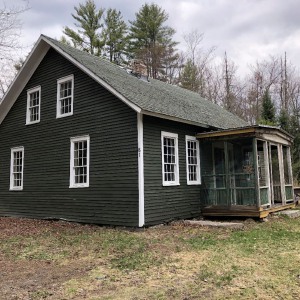Jim Kenyon: A school cut short

Jim Kenyon. Copyright (c) Valley News. May not be reprinted or used online without permission. Send requests to permission@vnews.com.
| Published: 09-24-2023 7:06 AM |
I tend to lump hair salons into the same category as funeral homes. No matter how the economy is doing, their services are always in demand.
With that in mind, it’s surprising to hear the New England School of Hair Design is shutting down next month.
The nationally accredited school, which started out in Claremont before moving to West Lebanon in 1985, has been in business for 46 years. It’s trained hundreds of hairstylists over the years while providing haircuts, perms and other beauty services at bargain prices. (Haircuts start at $12.)
The school’s closing comes at a time when hairstylists seem in short supply.
A sign on the front door of Supercuts in West Lebanon lets customers know the salon now closes at lunchtime due to a staffing shortage. The shop has four full-time and three part-time stylists. Jean Perron, Supercut’s manager, told me that she could use more, but they’re not to be found.
New England School of Hair Design President Crystal Hicks, herself a 2000 graduate, told me in an email that she sometimes questions her decision to shutter the business, “wondering if I could have pushed through a bit longer, but it is clear the required resources to continue are just not available.”
Hicks, the school’s director since 2004, and her husband, Dennis, acquired the school from longtime owners Gary and Brenda Trottier in 2017.
In March 2020, the COVID-19 pandemic struck. Even with the lifting of mask restrictions, Hicks said, she’s been unable to bring the school “back to pre-pandemic productivity.”
Article continues after...
Yesterday's Most Read Articles
 Dartmouth administration faces fierce criticism over protest arrests
Dartmouth administration faces fierce criticism over protest arrests
 Hanover house added to New Hampshire Register of Historic Places
Hanover house added to New Hampshire Register of Historic Places
 Sharon voters turn back proposal to renovate school
Sharon voters turn back proposal to renovate school
The school has gone from 55 students in its heyday to fewer than 20 in recent years, she said. Hicks doesn’t blame the enrollment decline entirely on the pandemic.
A large number of her students came from Vermont. In 2019, the Vermont Legislature, however, reduced the hours of instruction required to qualify for a state license from 1,500 hours to 1,000. (In most states, including New Hampshire, 1,500 hours or more are needed.)
The change opened the door for Vermont’s vocational high schools to play a much larger role in the training of future cosmetologists. And for New England School of Hair Design, it spelled the beginning of the end.
Before Vermont cut the number of hours by one-third, students could only get a fraction of their training in high school. After graduating, they needed another year or so of post-secondary schooling.
No more.
Last year, the Hartford Area Career and Technology Center expanded its cosmetology program to make it possible for students to meet state licensing requirements while still in high school. Other vocational high schools in Vermont are doing the same.
It’s been a boon for young cosmetology students. They avoid the time — and more importantly, the expense — of attending a post-secondary school to complete their training.
“I tell students they’re getting a $25,000 education for free,” said Stacey Dunham, director of the cosmetology program at Hartford Area Career and Technology Center.
She also reminds students that they’re fortunate to have taxpayers picking up the cost of their education.
It wasn’t that way when Heather Cray graduated from high school in 2011. Cray, a hairstylist at Just Paradise in West Lebanon, had a 300-hour head start on her licensing requirement from her classes at Hartford’s career and technology center.
But to complete her training at New England School of Hair Design, she borrowed about $22,000 to cover tuition and to purchase scissors, clippers and other tools of the trade. She lived at home and worked as a waitress while going to school six hours a day.
The career path is shaping up to be much different — and arguably less arduous — for many of today’s cosmetologists-in-training. At the Hartford Career and Technology Center, which serves students from a dozen Upper Valley high schools, the training is spread over students’ junior and senior years.
There’s also an online component. The 32 students under Dunham’s tutelage this year work outside the classroom on the textbook portion of the program.
“Another nail in (her school’s) coffin,” as Hicks put it, came in June. New Hampshire Gov. John Sununu signed a bill that paves the way for cosmetologists already licensed in other states to work in New Hampshire without reaching 1,500 hours of schooling.
New Hampshire’s chief concern is that cosmetologists receive sufficient health and safety training, said Lindsey Courtney, executive director of the state Office of Professional Licensure and Certification. In those areas, training in Vermont and Massachusetts, which also requires 1,000 hours, is “substantially similar” to New Hampshire, Courtney said.
The shuttering of New England School of Hair Design could impact more than just owners and employees. Adults in the Upper Valley who are looking to make a career change to cosmetology have one less option. By Hicks’ count, only five private school remains in New Hampshire and one in Vermont.
The good news is that discussions are under way about starting a training program for adults at the Hartford Career and Technology Center, Dunham said. “It will take time to develop, but there’s a definite need in the Upper Valley,” she said.
It’s hard to argue against the licensure changes New Hampshire and Vermont have made, if it means young cosmetologists in particular are getting saddled with less student loan debt or, better yet, none at all.
On Friday evening, I caught up with Hicks outside her school. She’s working nights with three students who are trying to graduate before the school closes in a couple of weeks.
Hicks takes some consolation in knowing her school had a good run. But in the end, her business model fell out of style.
Jim Kenyon can be reached at jkenyon@vnews.com.

 Editorial: Response to campus protests only adds fuel to the fire
Editorial: Response to campus protests only adds fuel to the fire Editorial: Chris Sununu’s moral vacuum
Editorial: Chris Sununu’s moral vacuum Editorial: Gambling tarnishes America’s sporting life
Editorial: Gambling tarnishes America’s sporting life By the Way: A white nationalist’s many mistruths
By the Way: A white nationalist’s many mistruths
